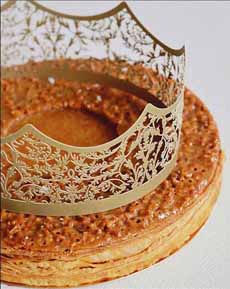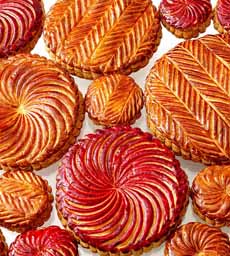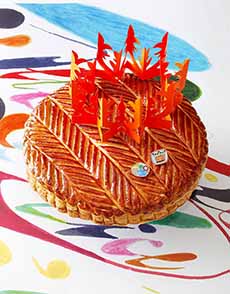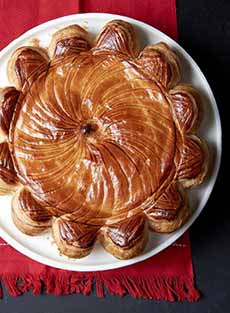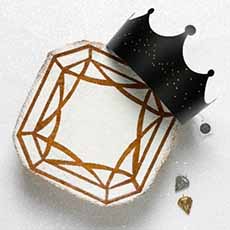FOOD HISTORY: Galette Des Rois, Epiphany Cake (The Original King Cake)
|
Epiphany, a Christian holiday celebrated on January 6th, marks the end of the Christmas season and the beginning of Carnival (which concludes with the beginning Lent). January 6th, which is 12 days after Christmas in the Gregorian calendar, is also known as Twelfth Night. It can get confusing to those not schooled in the tradition. Epiphany is also known as Three Kings Day, the Day of Kings and Feast Of The Kings (Fête des Rois in French). It’s the day that the Three Kings (les rois) appeared in Bethlehem bearing gifts for Baby Jesus. And it’s celebrated with a special cake, Galette des Rois (Cake Of The Kings, a.k.a. King Cake). Epiphany is celebrated with parties for children and adults alike. Whatever the food served, the “must have” is a Galette Des Rois (photos #1 and #2), otherwise known as an Epiphany Cake. The cake is a frangipane* tart. In France, people enjoy it throughout January, regardless of religious background. Composed of two circles of puff pastry (pâte feuilleté) with frangipane (almond-enhanced pastry cream) in between, each cake comes with a hidden charm or other trinket, called a fève, or bean†, baked into it. A gold paper crown, provided by the baker, sits on top. The person who gets the slice with the charm becomes “king” or “queen” for the day, and gets to wear the gold paper crown. But it’s an entailed honor: By tradition, the king or queen has to provide next year’s galette. Most people head to the nearest French bakery to buy a Galette Des Rois. But you can bake one: Here’s an Epiphany Cake recipe from the two-Michelin-star French chef Héléne Darroze. Hiding some type of token in food is a pre-Christian tradition, with roots in the Roman feast of Saturnalia‡. When the Church later instituted the Feast of The Epiphany to celebrate the arrival of the three wise kings, the tradition of the bean in the cake remained. The Galette Des Rois as we know it first appeared in the 14th-century [source]. Before the custom of the gold paper crown emerged (probably in the 19th century), the cake was covered with a white napkin and carried into the dining room. The tradition was adopted by other countries, to a more or less extent. While traditionalists like the cakes in the photos, others bake outside the box. Don’t eat sugar? Make a vegetable filling, like creamed spinach with a hint of nutmeg. ________________ *WHAT IS FRANGIPANE? Frangipane is a dense pastry cream flavored with almond paste. The almond paste base is enriched with sugar, butter and eggs. (Alternatively, milk, sugar, flour, eggs and butter are mixed with ground almonds). It is related to marzipan, which also has a base of almond paste. A key difference is that frangipane is a spreadable cream, and marzipan is a semi-hard almond candy. |
[4] Modern chefs add their own creative touches (photo © Breads Bakery | NYC).
|
|
|
†Modern trinkets can include anything from a charm to a coin to a plastic Baby Jesus. In earlier days, a bean was more available. Today, any meltable trinket is inserted into the bottom of the cake after baking. ‡Saturnalia, a festival spanning December 17-23, honored Saturn, the Roman god of agriculture. Festivals were organized in honor of the gods between late December and early January. A dry bean would be hidden in a dish prepared for the household staff (slave servants). The slave who got that helping would be given the “kingship,” which included drinking, gambling and general bawdiness. Many Christian celebrations date back to pagan customs. They were adapted by Christians to make religious conversion more familiar to pagans. The Christian festival of the Epiphany is even older than Christmas and Easter [source]. CHECK OUT WHAT’S HAPPENING ON OUR HOME PAGE, THENIBBLE.COM.
|
||
